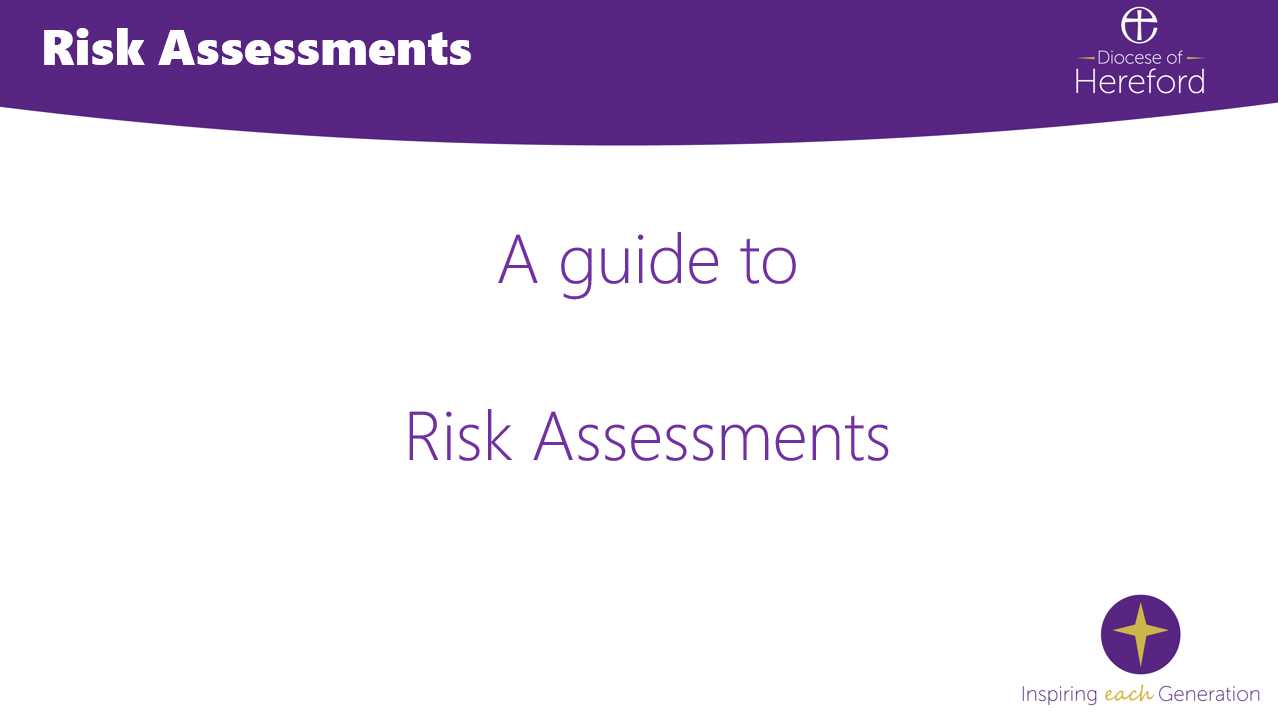Risk Assessment – Diocese of Hereford
Our first concern must always to be to protect those who are vulnerable – children, young people, and adults at risk. Activities/environments always carry a risk; what we have to do is minimise these. By doing this we will not only be protecting the vulnerable but also our workers, volunteers, our churches and off-site activities.
What is a risk assessment?
A Risk Assessment is looking at an activity / environment to identify potential risks or hazards (things that could cause harm or go wrong) for vulnerable groups (and others) and then thinking about what will need to be put in place to eliminate or reduce the identified risks. There could be things in the environment that can cause harm e.g. Trailing electrical wires, plugs that are accessible to small fingers or badly stacked chairs; or risks within parts of an activity, especially off site e.g. Crossing roads, transport arrangements. Some things will be a higher risk than others and it’s the high risks identified that must be addressed first as these have the potential to cause the greatest harm.
When will we need to do a risk assessment?
A risk assessment should be carried out for all activities which involve vulnerable groups before they take place. If an activity is regular, it should be risk assessed at the outset and then at regular intervals to ensure continued safety (at least annually). For one-off activities a risk assessment should be carried out well in advance. If the activity is to take place off site, part of the assessment should be to visit the venue so that all potential risks both on the journey and at the venue can be identified effectively.
The PowerPoint will guide you through the Risk Assessment process.
Risk assessment process
There are five questions you will need to address in order to identify the risks of an activity / event which will then enable you to identify the actions needed in order to make it safe according to the level of risk you have identified.
1. What are the potential risks or hazards? For example: crossing roads, open water, vehicles (as passengers), challenging behaviour, specific activities.
2. Who will be in attendance and may be at risk of harm? There is no need to list individuals by name – just think about the groups of children/young people / adults at risk and ‘staff’ who are taking part in the activity (including those with disabilities, special needs).
3. What are the risks to these groups? For each group, the potential risks or hazards should be considered.
4. What has been done to reduce the risks? Have precautions been taken against the risks from the hazards listed? E.g. Have the following been provided: adequate information, instruction or training, adequate systems, or procedures and policies including the Safeguarding Policy? Do the precautions represent good practice? Reduce the risk as far as reasonably practicable?
5. Is there anything else you can put in place to minimise risks? What more could reasonably have been done for those risks which were found to be not adequately controlled? There will be a need to give priority to those risks which affect significant numbers of people and / or could result in serious harm.
Estimating the level of risk
|
Trivial |
No action required – no recording necessary. |
|
Acceptable |
No action required, however, monitoring and recording is required to ensure that controls are maintained. |
|
Moderate |
Efforts should be made to reduce the risk. If a risk is associated with harmful consequences, further risk assessment will be necessary. |
|
Substantial |
The activity should not commence until the risk has been reduced or removed. |
|
Intolerable |
The activity should not be continued or started until the risk has been reduced or removed A risk assessment template is provided below. |
This should be completed and kept on file within the Church Area and should be available to see for any audit/visits. The headings are the core areas to be considered and should be added to for specific / unusual activities. The needs of those who will participate in the planned activities should be borne in mind at all times. You may like to consider reviewing the assessment after the event has taken place, especially if it’s likely to be repeated, to see if areas were missed or other actions could have been suggested / taken.
Please see below for Risk Assessment Tools and exanple Risk Assessments. You can change the documents to fit the need of your activity
Personal Risk Assessment Tool - Flow Chart
Blank example Risk Assessment Template
